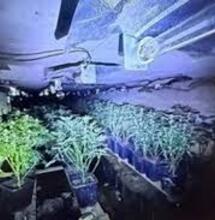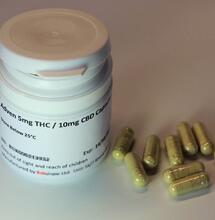Flush It... Don't Rush It!

It can mean the difference between a harsh or smooth smoke, a natural or chemical taste and - in some cases - an extra few grams of yield. Flushing is one of the most important parts of your grow; yet is also one of the most overlooked. Let's take a look at this simple, but often misunderstood, technique.
It can mean the difference between a harsh or smooth smoke, a natural or chemical taste and - in some cases - an extra few grams of yield. Flushing is one of the most important parts of your grow; yet is also one of the most overlooked. Let's take a look at this simple, but often misunderstood, technique.
It can mean the difference between a harsh or smooth smoke, a natural or chemical taste and - in some cases - an extra few grams of yield. Flushing is one of the most important parts of your grow; yet is also one of the most overlooked. Let's take a look at this simple, but often misunderstood, technique.
Why Flush?
When cultivating plants using mineral nutrients, the NPK levels within a plant can become unbalanced and excess elements are stored within the tissue of the plant. This is particularly true in the case of cannabis cultivation where additives are given to the plant to trigger a specific reaction or process. For example, after the first two weeks of the flowering period it is common to administer a PK additive to trigger bud development and increase the weight and density of the buds.
Think of the amount of flowering stimulators, catalysts, ignitors and boosters that are available on the market; each proclaiming to be more powerful and concentrated than the last. The high percentage of mineral elements contained in those products, undoubtedly force an increased yield (some incredibly so!), but if they are not flushed out, they will be stored in the plant and affect taste.
End product from plants that have not been flushed can suffer from a ‘chemical' taste, smokers often complain that hydroponically grown weed has a different taste from soil grown, whereas in reality it is likely to have not been flushed properly.
Flushing also affects the ‘burn' of the end product. Next time you're smoking on some dealer-bought weed, take a look at the ash on the end of the joint; if it's been properly flushed, the ash should be light grey, with a fine, powdery texture. Ash created from burning weed that hasn't been flushed will be black, with a much more solid consistency and - in particularly bad cases - can pop and spark as the impurities still contained are ignited. I can recall a particularly nasty batch of commercial dope that crackled and popped so much, it was like toking on a fireworks display!!
| For the best end product... flush! |
What And When To Flush?
Any plant that has been raised on a mineral feed and additives should be flushed, regardless of the growing method or growing medium used. In pure hydroponic growing methods - like nutrient film technique or aeroponics - plants have constant access to mineral nutrients and, provided the solution in the reservoir is balanced, will constantly take all the elements they need via active uptake. These elements will be stored, in the root zone and plant sap, all the way until harvest.
Plants grown in soil or coco will also store excess elements. The medium around the roots provide a buffer that protects against over fertilisation. So, unlike in hydro where too much nutrient has an immediate effect on the plant, a soil grown plant may show no effects of over feeding, despite having a build-up of minerals around the roots. Therefore, flushing is still necessary.
The exception to the rule is growing on organics. With a mineral nutrient the plants are fed directly, using elements that can be immediately taken up by the plant. With an organic feed, you are feeding the microbes within the soil. These microbes then produce elements that the plant takes up. The plant is not fed directly. As a result, there is no excess of minerals stored in the plant and you can feed until the day you chop.
One other thing to bear in mind is that a flushing product can be used to clear out any mineral build ups that have occurred through over-feeding, at any stage of development - a sort of colonic irrigation for plants! If your girls are starting to show signs of nutrient overdose - crisping at the edge of the leaves for example - use a flushing agent with water in your hydro system or pots. This will minimise the stress caused by the over-feed and aid your plants' recovery.
| Black ash means excess minerals are still stored in the bud |
How Does A Flush Work?
The simplest method of flushing is to just feed water in the last week or two before harvesting. The lack of elements being fed to the plant forces it to use up the excess elements stored within its tissue. This method is effective, but there is still likely to be some excess minerals left within the plant, particularly if concentrated mineral additives have been used.
There are various flush products on the market, each based on different techniques of removing, or forcing the use of, excess nutrients stored within the plant. These techniques include;
Stress - when the flush is administered it creates a root stress that forces energy in the plant to be expended, therefore using up the excess nutrients stored and ripening the plant at the same time. Some of the flushes that employ this technique are so powerful that they actually destroy the roots of the plant, triggering a survival instinct, forcing all of the energy into reproduction (i.e. the buds).
Mineral Salts - a good technique for pure hydroponic systems where the roots are exposed. Large mineral particles are added to the flushing solution, these particles are too large to be taken up by the plant, but when washed through the roots will attract any excess mineral deposits that have built up and wash them away.
Hormones - flushes containing natural plant hormones will trigger a natural reaction in the plant that forces it to mature and finish. This uses up excess minerals stored and also ripens the fruit, improving quality and yield.
Some of the better flushes on the market use a combination of techniques to get the best result.
Temptation is a dangerous thing for the home grower, from the excited first timer to the seasoned expert; when those buds get ripe, they're hard to resist! Just remember, for a smoother, tastier smoke, it's so worth hanging on that extra week. Trim and smoke a few air buds if you have to, just make sure you flush before you chop the main harvest.
And, don't forget to cure it properly!
Happy flushing!



